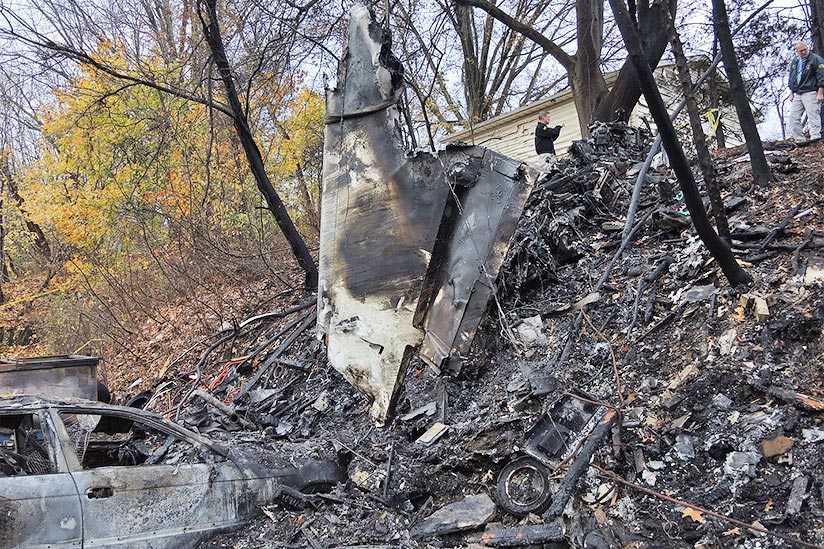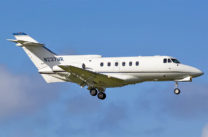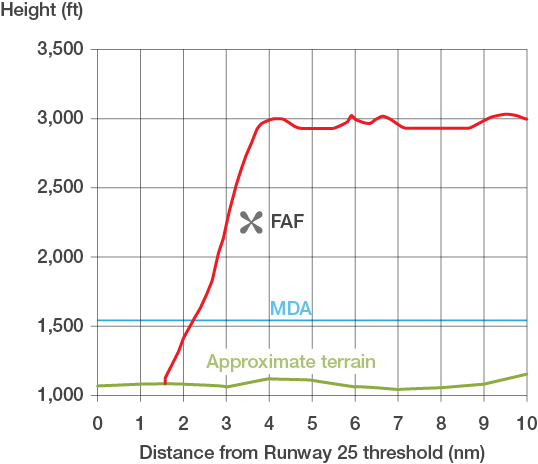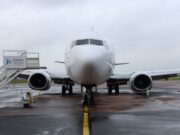
The localizer approach conducted by the flight crew of the British Aerospace Hawker 700A was grossly unstabilized, but neither pilot called for a go-around. The captain was aware of serious discrepancies — dangerously low airspeed, the foremost — and made several critical comments to the first officer, the pilot flying; but he did not take control of the airplane.
The captain actually encouraged the first officer to descend below minimums despite not having any of the required elements in sight.

Source: U.S. National Transportation Safety Board
Far behind the power curve, the Hawker eventually stalled and descended out of control onto the front yard of an apartment building near the Akron Fulton (Ohio, U.S.) International Airport. The airplane exploded on impact and then plowed through the apartment building. Much of the wreckage came to a halt against an embankment in the backyard.
The impact and post-impact fire killed the pilots and their seven passengers. No one on the ground was hurt in the crash, which occurred the afternoon of Nov. 10, 2015.
Based on the findings of its investigation, the U.S. National Transportation Safety Board (NTSB) concluded that the probable cause of the accident was “the flight crew’s mismanagement of the approach and multiple deviations from company standard operating procedures [SOPs], which placed the airplane in an unsafe situation and led to an unstabilized approach, a descent below minimum descent altitude without visual contact with the runway environment and an aerodynamic stall.”
‘Missed Opportunity’
The NTSB’s final report said that factors contributing to the accident included the aircraft operator’s “casual attitude toward compliance with standards; its inadequate hiring, training and operational oversight of the flight crew; [and] the company’s lack of a formal safety program.”
The Hawker was operated by Execuflight, an on-demand passenger and cargo carrier based in Fort Lauderdale, Florida. At the time of the accident, the company operated six business jets and employed 11 pilots.
The pilots of the accident airplane were hired by Execuflight in June 2015. “Both pilots were foreign nationals (the captain was from Colombia, and the first officer was from Italy), and each held an English proficiency declaration on his FAA [U.S. Federal Aviation Administration] pilot certificate,” the report said.
The captain, 40, held U.S. and Colombian airline transport pilot certificates and a type rating in the Hawker 700/800. He flew for several aircraft operators in both countries before joining Execuflight. He had 6,170 flight hours, including 1,020 hours in Hawkers, of which 670 hours were as pilot-in-command.
The first officer, 50, held a U.S. airline transport pilot certificate and type ratings for the Learjet and Hawker. He flew as second-in-command of corporate and on-demand business jets and for a supplemental airline before being employed by Execuflight. He had 4,382 flight hours, including 482 hours in Hawkers.
Execuflight conducted required Pilot Records Improvement Act (PRIA) background checks of both pilots before hiring them. The captain’s PRIA records showed that the FAA had taken enforcement action against him in 2014 for an operation contrary to an air traffic control instruction. The agency closed the enforcement action after he received remedial training.
About two months before joining Execuflight, his employment with a corporate operator had been terminated for failing to report to a training provider for recurrent training. Execuflight did not contact the corporate operator for additional information about the termination. The president of the company told investigators that he hired the captain based on his previous experience in Hawkers and three or four noncommercial flights he made with him.
About three months before he was hired by Execuflight, the first officer’s employment with the supplemental airline had been terminated for unacceptable progress in training as a Boeing 737 first officer. Records showed that the airline’s chief pilot had described his performance in a flight simulator as “ridiculously weak.”
Execuflight did not contact the airline for further information. The president said that he hired the first officer based on a recommendation from another pilot and one noncommercial flight with him. He told investigators that he “didn’t get in deep into his file” because he was hiring him as a second-in-command.
The NTSB concluded that the company’s evaluation of the pilots’ records before hiring them was cursory. “Although the captain’s termination for failing to attend training was not related to his competence as a pilot, the first officer’s recent training difficulties were substantial and should have raised concerns with Execuflight management about the first officer’s competence,” the report said.
“Because Execuflight did not fully evaluate the information it had concerning the first officer’s significant training difficulties at his previous employer, the company missed an opportunity to determine if the first officer was fully capable of operating its airplanes safely.”
First Officer at Controls

Source: U.S. National Transportation Safety Board
The pilots had flown together three times, for a total of about 32 hours, in the 90 days preceding the accident, which occurred on the second day of a two-day trip with the seven passengers.
The pilots had flown the day before from Fort Lauderdale to locations in Minnesota and Missouri before landing and remaining overnight at Cincinnati, Ohio. On the day of the accident, the Hawker was flown to Dayton, Ohio, landing at 1133 local time.
The airplane departed from Dayton at 1413 for the 34-minute flight to Akron. “Contrary to Execuflight’s informal practice of the captain acting as pilot flying on flights carrying revenue passengers, the first officer was the pilot flying and the captain was the pilot monitoring,” the report said.
The airplane was manufactured in 1979 and was equipped with a cockpit voice recorder (CVR). It did not have, and was not required to have, a flight data recorder. The report noted that the CVR recording was of poor quality, a deficiency that had not previously been detected during functional testing of the unit.
While cruising at 17,000 ft, the crew attempted to obtain the automated surface observing system (ASOS) information for Akron but selected an incorrect radio frequency and received information for an airport about 100 nm (185 km) south, which was reporting visual meteorological conditions.
The crew began the descent into Akron at 1429. Recorded radar data showed that the Hawker’s airspeed was 298 kt — 48 kt above the maximum speed ascribed by regulations — as it descended through 10,000 ft. Neither pilot commented on the discrepancy.
During the descent, the crew selected the correct frequency for the Akron airport’s ASOS, which was reporting surface winds from 240 degrees at 8 kt, 1 1/2 mi (2,400 m) visibility in mist and an overcast ceiling at 600 ft.
Inconsistent Briefing
Although the pilot flying typically conducts approach briefings, the first officer asked the captain to brief the localizer approach to Akron’s Runway 25. The report said that the briefing was “unstructured, inconsistent and incomplete … and began before the crew had the most current weather at [Akron] on which to base the approach brief.”
The CVR recording indicated that the first officer expressed confusion about the minimum descent altitude (MDA) for the localizer approach because he was referring to the chart for the global positioning system approach to Runway 25 during the briefing.
The report also said the first officer made several statements indicating that he believed the ceiling, rather than the visibility, was the controlling weather minimum for the approach.
“While determining when the airplane is expected to break out of the clouds can assist in managing the expectations of the approach, visibility is the controlling element of an approach, and the conversation between the two pilots led to an ambiguous expectation of when they would acquire visual contact with the ground and the runway environment,” the report said.
The chart for the localizer approach showed an MDA of 1,540 ft — which was 473 ft above touchdown zone elevation — and a minimum visibility of 1 1/4 mi (2,000 m) for Category C airplanes like the Hawker.
Too Fast, Too Slow
The Hawker was at 9,000 ft when the captain established radio communication with an approach controller, who issued a vector for the approach, told the crew to descend to and maintain 3,000 ft until established on the localizer course and to reduce their speed to 170 kt because they were following a slower airplane on the approach.
Airspeed was 280 kt when the airplane leveled at 3,000 ft. To slow down, the first officer extended the flaps to the approach setting and lowered the landing gear. At this point, the airspeed trend changed from too fast to too slow.
A performance study conducted by the NTSB indicated that the airplane’s pitch attitude increased from 5 degrees to 12 degrees while airspeed decreased to 125 kt. The captain warned the first officer twice about the airplane’s high pitch attitude. The first officer responded by increasing power.
The Hawker was about 4 nm (7 km) from the final approach fix (FAF) when the crew was cleared for the approach. “The airplane was already established on the localizer when the approach clearance was issued and could have descended to the FAF minimum crossing altitude of 2,300 ft,” the report said. “However, the first officer did not initiate a descent, the captain failed to notice, and the airplane remained level at 3,000 ft.”
The captain made several comments about the low airspeed. “Look, you’re going one twenty,” he said. “You can’t keep decreasing your speed.”
The report noted that a proper airspeed for the airplane’s configuration was 144 kt and that the first officer apparently was not aware of the dangerous airspeed trend. In response to the captain’s warning, he said, “No. … How do you get one twenty?”
“That’s what I’m saying,” the captain said. “If you keep decreasing your speed … .”
The first officer interrupted by saying “but why?”
“Because we’re gonna stall,” the captain replied. “I don’t want to stall.”
‘Lack of Awareness’
The report said, “The first officer’s lack of awareness of his configuration and speed should have been an indication to the captain that the first officer was having difficulty flying the airplane in IMC [instrument meteorological conditions] and was not sufficiently familiar with the nonprecision approach procedures on the Hawker 700A to execute the approach safely.
“It was apparent that the first officer had lost situational awareness of the approach and [that] the circumstances were demanding more than his capabilities; however, the captain allowed the first officer to continue flying the approach. … The captain should have taken control of the airplane or called for a missed approach, but he did not do so.”
After being instructed by the approach controller to change to the airport’s common traffic advisory frequency, the captain made a position report and then heard one of the pilots of the preceding airplane radio that they “broke out right at minimums, (right at) a mile.”
Although this information indicated that the ceiling was near or at the MDA of 1,540 ft and that the visibility might have been lower than the required 1 1/4 mi, the Hawker pilots did not discuss it. “Such a transmission should have heightened the crew’s awareness that they needed to execute the approach flawlessly or consider executing a missed approach,” the report said.
The Hawker was nearing the FAF, still at 3,000 ft, when the first officer reduced power and called for full flaps. The captain did not question this decision although it was contrary to the SOP of keeping the flaps in the approach position until reaching the MDA and having assurance that the approach can be completed to landing.
An instructor at the training provider the pilots had attended told investigators that maintaining straight-and-level flight and target approach speed with full flaps would require “quite a bit of power.”
Another instructor said “it would be ‘nuts’ to do that since it would involve a lot of power, a lot of drag; and if the pilot was not paying attention to his speed, the airplane could slow and stall,” the report said.
‘You’re Diving’
Descent Profile

Source: U.S. National Transportation Safety Board
The captain began reciting the “Landing” checklist but did not complete it. Airspeed, which had stabilized briefly at 130 kt after the first officer increased power, began to decrease again. Indicated airspeed was 109 kt when the airplane crossed the FAF at 2,700 ft — 400 ft high.
The first officer then initiated a steep descent. “Because the airplane was high on the approach, it was out of position to use a normal descent rate of 1,000 fpm to the MDA,” the report said. “The airplane’s rate of descent quickly increased to 2,000 fpm, likely due to the first officer attempting to salvage the approach.”
The captain warned the first officer about the descent rate several times with increasing emphasis. “You’re diving,” he said. “You’re diving. Don’t dive. Two thousand feet per minute, buddy. … Don’t go two thousand feet per minute.”
The captain did not make the required altitude callouts during the descent or upon reaching the MDA. The airplane was still in IMC when it reached the MDA. Airspeed at this point was 113 kt.
Because the airplane was not configured properly and was 11 kt below the target landing airspeed, company SOPs required a go-around. “The approach was not stabilized, and the captain should have called for a missed approach according to SOPs, but he did not do so,” the report said.
‘Keep Going’
The first officer reduced the descent rate to about 830 fpm but did not level off at the MDA. The airplane was below the minimum altitude when the captain advised that he had ground contact and told the first officer to “keep going.” About seven seconds later, he said, “Okay, level off, guy.”
As the first officer attempted to arrest the descent, the stall-warning stick shaker activated twice. Investigators estimated that airspeed was 98 kt and angle-of-attack was 21 degrees — more than 5 degrees higher than the critical angle-of-attack — when the Hawker stalled and descended out of control to the ground, about 1.8 nm (3.3km) from the approach end of Runway 25, at 1453.
The airplane, the apartment building and two cars parked behind the building were destroyed by the impact and fire.
Autopsies and toxicological reports indicated that five of the passengers died of blunt force trauma on impact; the other two passengers and the pilots survived the impact but were unable to exit the airplane and succumbed from “inhalation of products of combustion and thermal injury,” the report said.
The NTSB made several recommendations based on the findings of the investigation, including that the FAA should require all commuter and on-demand aircraft operators to install flight data recording devices capable of supporting a flight data monitoring program, and to establish flight data monitoring programs and safety management systems.
This article is based on U.S. National Transportation Safety Board Accident Report NTSB/AAR-16/03, “Crash During Nonprecision Instrument Approach to Landing; Execuflight Flight 1526; British Aerospace HS 125-700A, N237WR; Akron, Ohio; November 10, 2015.”
Featured image: U.S. National Transportation Board


